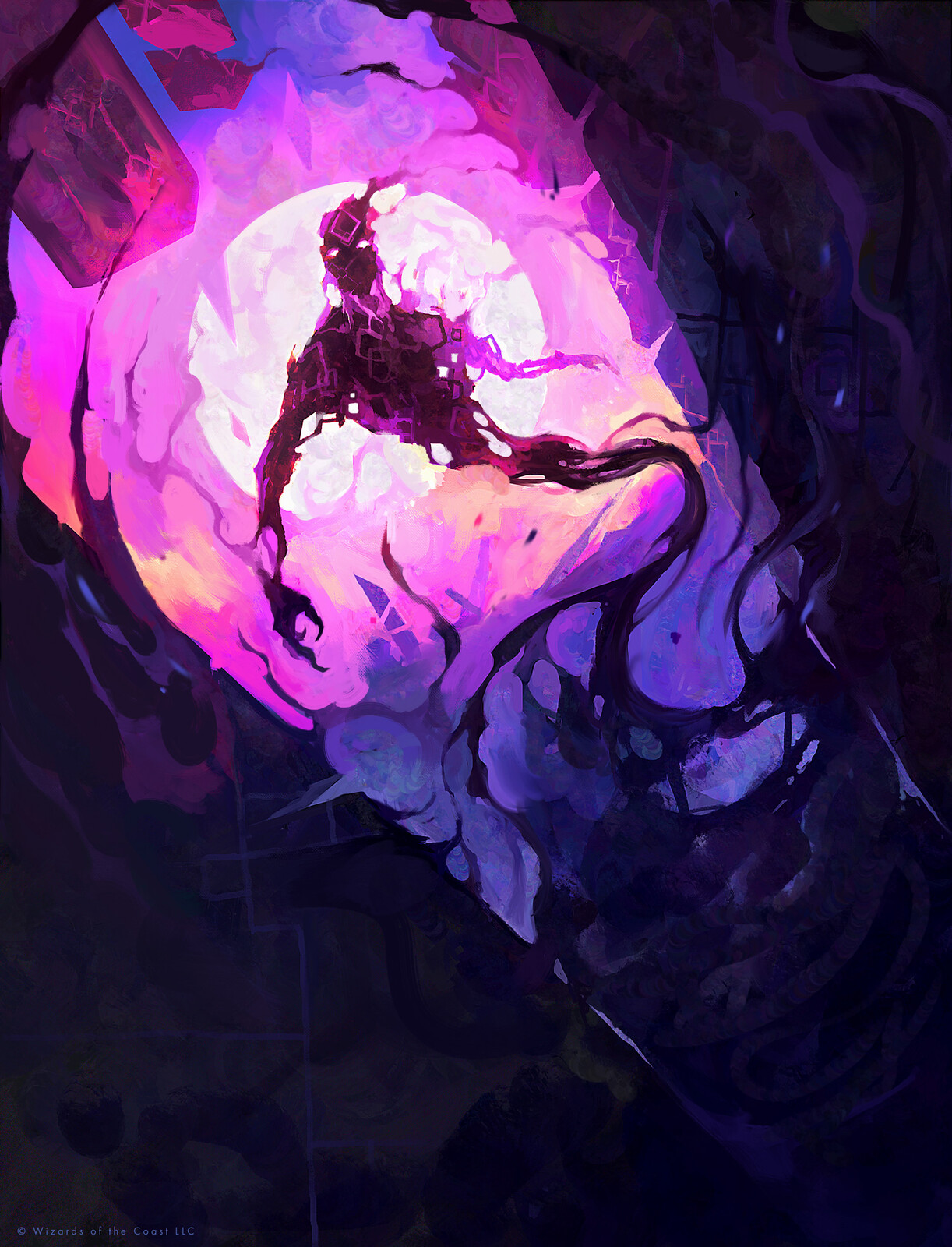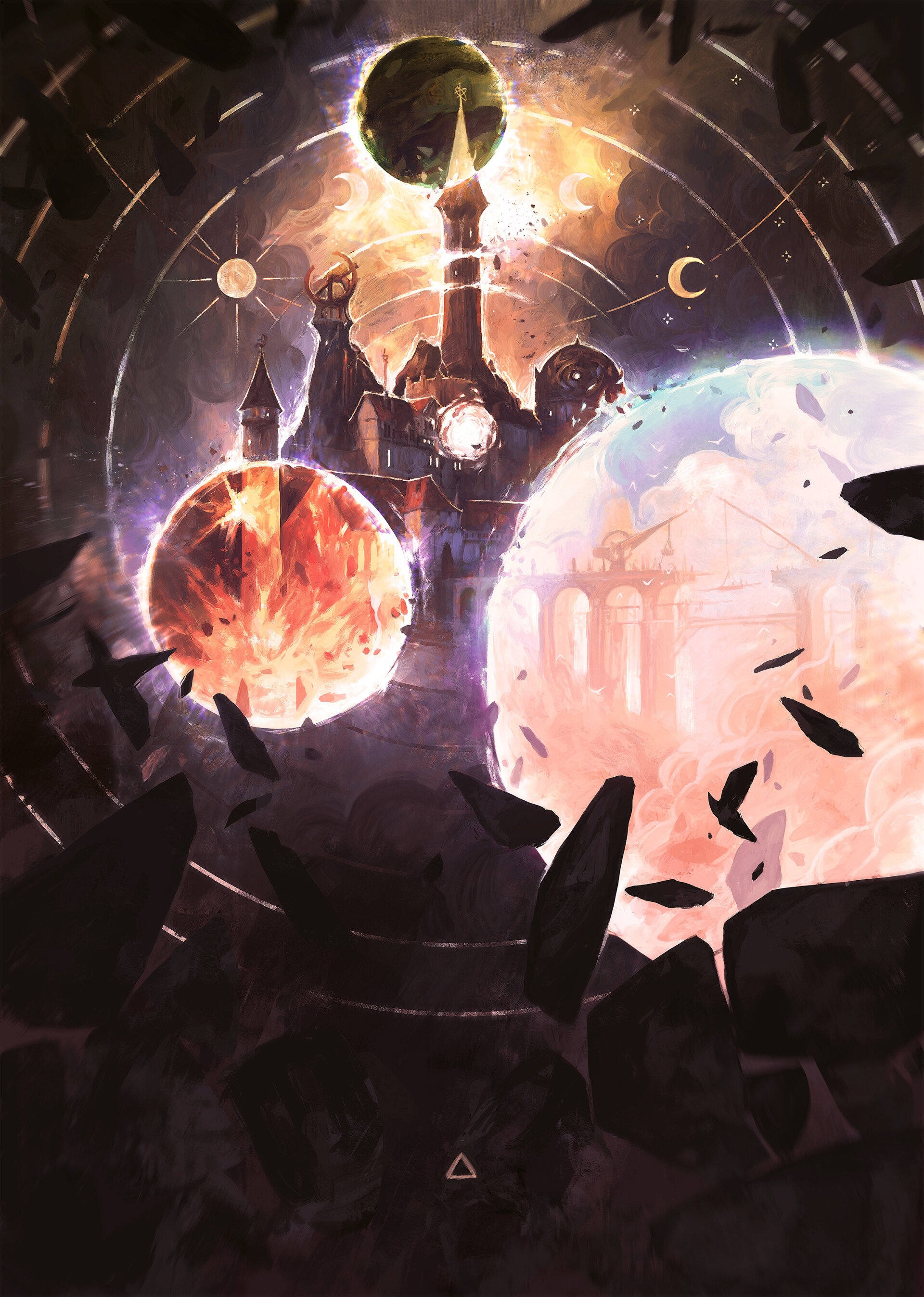


Wizard: Schools of Effect
In the Forgotten Realms, all magic is typically categorized into one of eight schools: Abjuration, Conjuration, Divination, Enchantment, Evocation, Illusion, Necromancy, and Transmutation- also known as the “Schools of Philosophy.” For ages, scholarly wizards toiled away classifying spells into one of these schools. Wizards analyzing each spell paid close attention to how a spell works, rather than the outcome it created, sorting the spell into the appropriate school. For instance, despite having very different effects, both the fireball and cure wounds spells are of the school of Evocation, characterized by the release of pure energy- fire, and healing energy. Likewise, the misty step and find familiar spells are both classified as Conjuration spells, despite only one of the spells truly “conjuring” an object. While this method of classification has largely been the norm for ages, there are other schools that a wizard may be trained in, such as the Schools of Effect.
As the name implies, the Schools of Effect work in the opposite direction of the Schools of Philosophy- categorizing by the outcome of the spell, rather than its origin. There are five Schools of Effect: Dimension, Elemental, Force, Incantation, and Shadow. The school of Dimension creates effects that manipulate the various dimensions of the world- time, space, and the planes. Elemental magic, quite
appropriately, creates some sort of elemental effect, such as a fireball or ice storm. The school of Force creates cohesive, tangible effects and objects seemingly from thin air, such as the creation of constructs. The school of Incantation is a bit more abstract; relating to spells that manipulate magic itself, such as shielding, banishment, and even metamagic. Finally, the school of Shadow encapsulates spells that harness the darkness from the Plane of Shadow, such as the darkness or chill touch spells.
Below are five arcane traditions specializing in the Schools of Effect. When making a character within one of these schools, think about why they have chosen to specialize in a School of Effect, rather than the traditional Schools of Philosophy. Perhaps you were raised in a secluded society, where the Schools of Philosophy had not yet reached. Maybe you grew bored of the traditional schools, and sought out a new school to study. You may even be from a distant, advanced civilization that has always used the Schools of Effect. Whatever the reason, your magical motives are clear: the effect is far more important than the cause.


School of Dimension
As a dimensionalist, you have firm control over the dimensions of time and space. Using your dimensional magic, you can effortlessly bend reality to your will- accelerating time, teleporting in and out of danger, and even shifting planes. While many wizards unknowingly use dimensional magic, it takes a true dimensionalist like yourself to master it.
Dimensional Spells
2nd-level School of Dimension feature
You add additional spells to your spellbook when you reach certain levels in this class, as shown in the Dimensional Spells table. If a spell is not on the wizard spell list, the spell nonetheless counts as a wizard spell for you. You always have these spells prepared, and they do not count against the number of wizard spells you can prepare each day.
Dimensional Spells *XGtE
| Wizard Level | Spell |
|---|---|
| 2 | Expeditious Retreat |
| 3 | Misty Step |
| 5 | Haste |
| 7 | Freedom of Movement |
| 9 | Far Step* |
Dimensional Stride
2nd-level School of Dimension feature
Your speed increases by 10 feet while you aren’t wearing heavy armor. Additionally, you can quickly apply your dimensional magic when entering battle. You can give yourself a bonus to your initiative rolls equal to your Intelligence modifier.
Swift Spellcasting
6th-level School of Dimension feature
Whenever you cast a wizard cantrip with a casting time of 1 action, you can choose to cast it as a bonus action instead. You can use this ability once, and regain the ability to do so when you finish a long rest, or when you cast a spell from your Dimensional Spells feature.
Unyielding Body
10th-level School of Dimension feature
Your foes have no control over your body in time nor space. Your movement cannot be reduced by any means, and you cannot be moved against your will. Additionally, you are immune to any spell or effect that would transport you to another location or plane against your will, unless you are incapacitated.
Arcane Sequestration
14th-level School of Dimension feature
You learn to open a pocket dimension outside of both space and time. As an action, you can enter this pocket dimension. The interior is dimly lit, and appears vaguely like the space you left, though no other creatures are present. While in this dimension, you can gain the benefits of a short rest, which feels like an hour to you. At the end of this rest, you return to the space you had previously occupied, with no time having passed in the world. Once you have used this feature, you can’t do so again until you finish a long rest.


School of Elements
Arguably the most direct school of effect, the School of Elements deals with the four elemental energies: water, fire, earth, and air. Elementalists specialize in spells relating to these elements, producing powerful effects from their raw power. Given their attunement to the natural elements, an elementalist can often be found at home with druids or rangers, perfecting their control of the elements around them, and learning to channel them through the weave. Some elementalists decide to focus on only one of these elements, warping their spells to match, while others prefer to be a generalist, working with all four of the elements.
Elemental Spells
2nd-level School of Elements feature
You add additional spells to your spellbook when you reach certain levels in this class, as shown in the Elemental Spells table. If a spell is not on the wizard spell list, the spell nonetheless counts as a wizard spell for you. You always have these spells prepared, and they do not count against the number of wizard spells you can prepare each day.
Elemental Spells *XGtE
| Wizard Level | Spell |
|---|---|
| 2 | Absorb Elements* |
| 3 | Dragon's Breath* |
| 5 | Protection from Energy |
| 7 | Elemental Bane* |
| 9 | Conjure Elemental |
Elemental Adaptation
2nd-level School of Elements feature
You can manipulate your elemental magic to suit whatever purpose may arise. Whenever you cast a wizard spell that deals acid, cold, fire, lightning, or thunder damage, you can change the spell’s damage type to another type in that list.
Additionally, you learn to speak, read, and write Primordial. Knowing this language allows you to understand and be understood by those who speak its dialects: Aquan, Auran, Ignan, and Terran.


Elemental Fury
6th-level School of Elements feature
Whenever you cast a wizard cantrip that deals acid, cold, fire, lightning, or thunder damage, you add your Intelligence modifier to the damage. Additionally, you add your Intelligence modifier to any damage dealt by a spell from your Elemental Spells feature (including damage dealt by your conjured Elemental).
Elemental Explosion
10th-level School of Elements feature
Your overwhelming elemental power spreads beyond a normal wizard’s scope. Whenever you cast a wizard spell of 1st level or higher that deals acid, cold, fire, lighting, or thunder damage, you can cause a burst of elemental energy. Each creature within 10 feet of you must make a Dexterity saving throw. On a failed save, a creature takes 1d6 damage and is pushed 10 feet away from you. The damage type is the same as the triggering spell.
Lingering Essence
14th-level School of Elements feature
Whenever you deal acid, cold, fire, lightning, or thunder damage to a creature, you can use your reaction to cause the elemental energy to cling to them, giving them vulnerability to that damage type until the end of your next turn. Once you have used this feature, you can’t do so again until you finish a long rest.
School of Force
The School of Force focuses on the physical manifestation of arcane objects. Practitioners of this school learn to create semi-tangible and cohesive effects, ranging from a simple Magic Missile to powerful arcane constructs. As you progress as a force mage, you will not only learn to make these arcane creations, but perfect them as well.
Force Spells
2nd-level School of Force feature
You add additional spells to your spellbook when you reach certain levels in this class, as shown in the Force Spells table. If a spell is not on the wizard spell list, the spell nonetheless counts as a wizard spell for you. You always have these spells prepared, and they do not count against the number of wizard spells you can prepare each day.
Force Spells **TCoE
| Wizard Level | Spell |
|---|---|
| 2 | Magic Missile |
| 3 | Spiritual Weapon |
| 5 | Leomund's Tiny Hut |
| 7 | Summon Construct** |
| 9 | Wall of Force |
Force Armor
2nd-level School of Force feature
You project a protective layer of force energy around yourself at all times. While you are not wearing armor or wielding a shield, your AC is 13 + your Intelligence modifier. This force armor can appear however you wish, and can even be invisible.
Force Adept
6th-level School of Force feature
You have resistance to force damage. Additionally, whenever you deal damage to a creature using a spell from your Force Spells feature (including damage dealt by your summoned Construct), You gain temporary hit points equal to half your wizard level (rounded up), as the force magic bolsters you.
Unstoppable Force
10th-level School of Force feature
Your control of force magic extends far beyond that of an ordinary wizard. Whenever you cast a spell from your Force Spells feature with a duration of 1 minute or greater, its duration is doubled, and your concentration can’t be broken as a result of taking damage.
Dome of Protection
14th-level School of Force feature
You can project a powerful protective dome of pure force energy to shield you and your allies. Whenever you or a creature within 10 feet of you takes any damage other than psychic damage, you can use your reaction to project a dome of force around you. Any creature within 10 feet of you (including yourself) takes no damage from the triggering effect. The dome remains until the start of your next turn. So long as a creature remains within 10 feet of you, they cannot take any damage from any effect originating outside of this dome, unless it is psychic damage. Once you have used this feature, you can’t do so again until you finish a long rest.
School of Incantation
The School of Incantation emphasizes a variety of magic used to banish, shield, and disrupt other spellcasters. As practitioners of magic in its rawest form, powerful incantatrixes learn to modify and manipulate their spells in the form of metamagic, and may eventually even learn to modify the spells of their allies. Beyond the manipulation of magic, incantatrixes excel in banishment, as well as protecting themselves and others from the harmful magic of rival mages.
Incantation Spells
2nd-level School of Incantation feature
You add additional spells to your spellbook when you reach certain levels in this class, as shown in the Incantation Spells table. If a spell is not on the wizard spell list, the spell nonetheless counts as a wizard spell for you. You always have these spells prepared, and they do not count against the number of wizard spells you can prepare each day.
Incantation Spells
| Wizard Level | Spell |
|---|---|
| 2 | Shield |
| 3 | Nystyl's Magic Aura |
| 5 | Counterspell |
| 7 | Banishment |
| 9 | Circle of Power |
Spellsense
2nd-level School of Incantation feature
You gain proficiency in the Arcana skill, and your proficiency bonus is doubled for any ability check you make that uses that skill. Additionally, you can attempt to identify a spell being cast without using your reaction. You can do so only once per round.
Reminder: Identifying a Spell
Whenever you perceive a spell being cast, you can use your reaction to make an Intelligence (Arcana) check to identify it. The DC for the check equals 15 + the spell's level. If it is cast as a wizard spell, you have advantage on this check. For more information, see page 85 of Xanathar's Guide to Everything.
Metamagic
6th-level School of Incantation feature
You learn two metamagic options of your choice from those available to the sorcerer class. If a metamagic option references your Charisma modifier in its description, you instead use your Intelligence modifier. To fuel these metamagic options, you have a number of sorcery points equal to half your wizard level (rounded up), and you regain all spent sorcery points when you finish a long rest. You learn an additional metamagic option at 10th level, and again at 14th level.
Additionally, whenever you regain spell slots through your Arcane Recovery feature, you can regain a number of sorcery points equal to your proficiency bonus.
Spell Seizure
14th level School of Incantation feature
You learn to capture the spell of another creature as they cast it and turn it against them. Whenever you successfully negate a spell using Counterspell, you can choose to seize the spell as a part of the same reaction. If you choose to do so, you cast the negated spell instead, using your level and spellcasting modifier, but without spending a spell slot. If the spell is not a wizard spell, it nonetheless counts as a wizard spell for you. Once you have used this feature, you can’t do so again until you finish a long rest.


School of Shadow
Practitioners of the School of Shadow draw their dark power from the Plane of Shadow, quickly acquiring powerful darkvision from their exposure to its dark forces. Shadow magic is a dark and mysterious school, often stigmatized and feared by outsiders- for good reason. Many shadowcasters are confronted by their “shadow self” as they begin to delve into the depths of shadow magic. This shadow self is a dark reflection of their true self, polar opposite in nature. If a mage does not have the mental fortitude to withstand this apparition, they may quickly descend into madness.
Shadow Spells
2nd-level School of Shadow feature
You add additional spells to your spellbook when you reach certain levels in this class, as shown in the Shadow Spells table. If a spell is not on the wizard spell list, the spell nonetheless counts as a wizard spell for you. You always have these spells prepared, and they do not count against the number of wizard spells you can prepare each day.
Shadow Spells *XGtE **TCoE
| Wizard Level | Spell |
|---|---|
| 2 | Arms of Hadar |
| 3 | Darkness |
| 5 | Summon Shadowspawn** |
| 7 | Evard's Black Tentacles |
| 9 | Enervation* |
Shadow Sight
2nd-level School of Shadow feature
You can see normally in darkness, both magical and nonmagical, to a distance of 120 feet.
Touch of Darkness
6th-level School of Shadow feature
Your shadow magic permeates the senses of those it touches. Once per turn when you deal damage to a creature using a spell from your Shadow Spells feature (including damage dealt by your summoned Shadowspawn), you can force it to make a Constitution saving throw. On a failed save, the creature is blinded until the end of its next turn. Only one creature can be blinded by this feature at a time.
Sustaining Shadows
10th-level School of Shadow feature
Your connection to the Plane of Shadow has permanently altered your body. You gain resistance to cold and necrotic damage. Additionally, you no longer need to eat, sleep, or breathe.
Tragic Sanity
14th-level School of Shadow feature
Your exposure to the darkness of your shadow self has made you numb to the darkness of the world around you. You are immune to psychic damage.
Additionally, whenever a creature targets you with an effect that would charm or frighten you, you can use your reaction to reflect the effect. The original creature must make a Wisdom saving throw against your spell save DC. On a failed save, the creature is charmed or frightened (based on the original effect) for 1 minute. At the end of each of their turns, the creature can repeat their saving throw, ending the effect on a success. Once you have used this feature, you can’t do so again until you finish a long rest.
The Schools of Effect
The Schools of Effect originally appeared in Advanced Dungeons & Dragons in Player's Option: Spells & Magic. This book introduced the schools of Air, Earth, Fire, Water, Dimensional Magic, Force, and Shadow. Two years later, Cult of the Dragon would introduce the school of Incantation. Originally, the school school of Incantation was not considered a school of effect, though it later became known as one of them. This supplement attempts to convert these alternative schools for usable play in 5th edition, without complicating the existing classification of spells. For simplicity's sake, the schools of Air, Earth, Fire, and Water have been folded into the all-encompassing school of the Elements as well.
Credits:
Subclasses designed by RW_Blackbird
All art by Dominik Mayer on ArtStation
